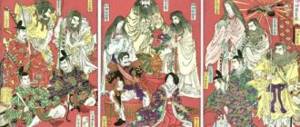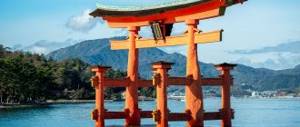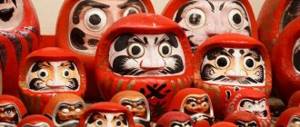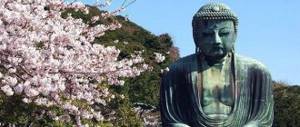Amaterasu is one of the key characters in the Japanese pantheon. She is called the Goddess who shines in the heavens, the Lady of the sky, the Great Sacred Goddess, the Sun Goddess. Shintoists are confident that the imperial family descends from Amaterasu - her great-great-great-grandson became the first emperor of the country. In Japanese history and mythology, she is the inventor of a method of growing rice, producing silk; she gives humanity the loom.
Amaterasu
Origin, history
The origin of Amaterasu is revealed through ancient legends. Japanese gods appeared long before people - many generations of deities were born before the first man appeared. The last were Izanagi and Izanami - brother and sister, who married and created the Japanese archipelago, and also gave birth to many goddesses and gods. When his wife died, her husband tried to bring her back from the kingdom of the dead, but he defiled his essence by not winning. To cleanse himself, the great Izanagi took a bath. From all the pieces of clothing he took off, gods and goddesses appeared, and from the water that washed his left eye, Amaterasu was born. Japanese mythology says that the water with which Izanagi washed his right eye gave birth to the moon god Tsukuyomi.
The father gave Amaterasu the task - to own the plain of the sky, keep his father's necklace, and shine for the good of people. In its history, the deity Susanoo played an important role - the brother who appeared from Izanagi’s nose. Susanoo refused to rule the waters, as his father wished, and went to his mother in the underworld. When leaving, he announced his desire to say goodbye to his sister, but his cunning plan immediately became clear to her. The goddess offered to fight and lost the fight. The winning Susanoo joyfully destroyed rice plantings and canals of irrigation systems, and ended the holiday by skinning a live horse, whose body he threw into his sister’s chambers. Amaterasu, angry, hid in a cave - so the world lost light. The entire pantheon of Japanese gods began to look for a way to persuade the goddess to return, because without light there is no life.
The sacred gods found a red rooster, made a mirror decorated with gems and asked Ame no Uzume to dance on the vat so that the sound resembled war drums. The dance of the goddess, the crowing of a rooster, and the loud laughter of those around attracted Amaterasu's attention. The sacred goddess looked out from the grotto, light returned to the world.
Legends tell about Amaterasu
Legends of Japan. Sun Goddess
Home › Sandbox. Archive of Articles and Author's Techniques › Gods, Pantheons and Mythology › Pantheons of Japan and China › Legends of Japan. Sun Goddess
- Valsad
- 0
- no comments
Amaterasu, the sun goddess, took the throne in the distant, deep, blue vault of heaven. Her radiance served as glad tidings to the heavenly deity.
Orchids and iris, cherry and plum flowers, rice fields and hemp plants answered her smile with smile, and lakes and waters reflected her in thousands of sparkling colors.
But Susano-o, brother of Amaterasu, who ruled over the ocean and now ruled for the god of the month, was jealous of his sister’s glory and all-conquering power.
One whisper of the goddess emitting rays was enough, and all the light turned into hearing, and her voice was perceived in the depths of the crystals and at the bottom of the mirror-transparent lake.
Her rice fields yielded abundantly, whether they were on a mountain slope, in a sheltered valley, or beside a raging stream, and her fruit trees bowed under the weight of their fruit.
But Susano-o’s voice was not so pure, his smile was not so luminous. Its fields surrounding the chambers were often flooded and they perished; his rice crops also died from time to time.
The god of the month’s anger and frustration knew no bounds, but Amaterasu was infinitely patient and forgave him everything.
One day the sun goddess was sitting, as always, preoccupied with work, in the courtyard of her heavenly home, spinning. Spinners of heavenly origin of rare beauty surrounded the springs, over the waves of which the fragrance of lotus flowers floated, and wonderful songs were heard, announcing the wind, clouds, and the vault of heaven.
And suddenly, through the blue sky, the frozen corpse of a pinto horse, the favorite of the gods, fell at the feet of the spinner. The envious Susano-o killed him and skinned him.
At the sight of the horse, Amaterasu shuddered and pricked her finger with a spindle and, outraged by her brother’s ferocity, withdrew into the cave and locked the door of the heavenly dwelling in the rock behind her.
The whole world plunged into darkness. Joy and good nature, spiritual purity and peace, hope and love - disappeared with the fading light. The evil spirits, which until then had been lurking in dark corners, finally dared to come out into the wild and began to wander everywhere. And their terrifying laughter, their mind-clouding songs filled the hearts with horror.
In the end, all the gods, who feared both for their safety and for the existence of everything beautiful in the world, gathered in the bed of a heavenly stream, the waters of which had dried up.
Everyone knew that only Amaterasu could help them. But how can they persuade the heaven-illuminating goddess to enter this world of darkness and discord?!.. Eight hundred deities were invited to the council, and finally a plan was found to bring Amaterasu out of her imprisonment.
And so Amenako uprooted the sacred Sakaki trees that grow on the heavenly hills and planted them in front of the entrance to the cave. High on the top branches hung valuable chains made of shiny precious stones, which Izanaki had given to the sun goddess.
The middle branches were occupied by a mirror made of noble metals from the heavenly mountains. Its shiny surface emitted rays from itself, like the face of the sun.
The other gods wove a royal robe of white and blue from fiber, hemp and paper mulberry, which they hung on the lower branches of the Sakaki tree as a sign of expression of their zeal.
A palace was also built, surrounded by a garden, in which the goddess of plants commanded many thousands of her favorite plants and flowers to bloom. And now everything was ready.
Then Amenako stepped forward and in a loud voice asked the sun goddess to show herself to them... but in vain. Then the great celebration began. Uzume, the goddess of joy, sang loudly and began to dance in a circle.
Heather leaves adorned her head, and dry stems from the heavenly mountain Kagu girded her flexible figure; wild grapes twined around her flowing sleeves while she held in her hand wild bamboo leaves, hung like a magic wand with tiny melodious bells.
Uzume played the bamboo flute, while eight hundred myriads of deities accompanied her with their musical instruments. Some rattled like wooden rattles; others had instruments with a stretched bowstring, along which they drew stalks of wolf and simple grass with the speed of lightning; a huge fire was lit around the cave, and when the mirror reflected its glow, the “long-singing birds of the eternal night” began to shout, as if morning had dawned. The gaiety took its toll.
The ranks of the gods became more and more animated, and the gods laughed so much that the sky shook as if from thunder. Amaterasu listened motionless in her solitude to the crowing of roosters, the sounds of music and the noise of dancing; but when the sky shook with the laughter of the gods, she cautiously looked out from her hiding place and asked:
- What does it mean? I thought heaven and earth were in darkness, but I see light. Uzume dances and all the gods laugh! Uzume replied:
“I can dance, and the gods can laugh, because among us there is now one deity whose beauty is like yours!” Look!..
Amaterasu glanced at the mirror and was terribly surprised to notice a goddess of supernatural beauty in it. She left the cave, and at the threshold, immediately in front of the entrance, a rope of rice straw was twisted so that the goddess could not hide back. The darkness disappeared and light appeared.
And then eight hundred myriads of deities exclaimed:
- Oh, may the sun goddess never leave us!
Share this post:
Religion
Amaterasu Oomikami (there are spellings “omik ami” and “oo mika mi”, but it is more correct to write “Oomikami” or “Oomi-kami”) is found in religious legends of antiquity, but her cult acquired particular strength at the end of the 7th century, simultaneously with the strengthening of the clans of the central parts of the country, the formation of the early Japanese state. During this period, myths appear that the descendant of Amaterasu Ninigi no Mikoto is a messenger from heaven, sent to restore peace and the rule of the gods in the archipelago. For the journey of the descendant, Amaterasu gives objects that have since been considered imperial symbols - a sword, a mirror, jasper. Only the grandson of the heavenly messenger was able to achieve the title of the first Japanese emperor.
Amaterasu is part of the way of Shinto
For the first centuries, the cult of Amaterasu was performed only in the imperial palace, then the mirror of the goddess was moved to Naika in Ise, at the same time declaring the temple central to the cult. During the reign of Tokugawa, the emperor strengthened his position, his symbolism acquired greater significance, and Ise became a center of pilgrimage. During the Meiji period, Shintoism acquired the status of a state religion, and Ise turned into a national shrine. For the Shinto-Buddhist cult, which formed after the 13th century, Amaterasu is the Mahavairocana Buddha.
Shintoism
For Shinto, the main religious story is the myth of Izanagi and Izanami, the story of the origin of Amaterasu and the appearance of Emperor Jimmu. For Shintoists, Amaterasu is one of the kami, deities worthy of worship.
In Shinto, places of worship for kami are jinja shrines, where kannushi priests perform rituals and are assisted by miko priestesses. Every year, thousands of matsuri festivals are organized at the shrines, which initially had only a religious meaning, but over time expanded their meaning.
In Shintoism, an important part of the trend is associated with Amaterasu - the so-called imperial Shintoism, that is, ceremonies allowed only in the imperial palace. These are secret ceremonies, to which only the reigning family and close courtiers are allowed, and the emperor is in charge of the main rituals. Since since ancient times the rituals of Amaterasu were considered so closed, the association of the ruler and the main deity became even stronger among the people. Imperial Shintoism was banned during World War II.
Amaterasu - an element of imperial Shintoism
Reflection in myth of the role of the emperor as the highest authority in tribal society
The goddess Amaterasu, revered in the Ise-jingu sanctuary, was considered the supreme deity according to the laws of the 7th-8th centuries, but she also has another aspect - being the main deity, she herself serves some unnamed and undefined gods. Before hiding in the cave, she makes the kammiso, the clothing worn by the deities, for the gods. What are we talking about here?
In the “Annals of Japan” another name of Amaterasu is mentioned - Oohirume (oo - “great”, hi - “sun”, ru (ligament), me - “wife”, that is, the Wife of the Great Sun) - in other words, a servant of the sanctuary who honors male solar deity. There is a theory that at one time her status rose to that of the Sun Goddess. In different regions of the world there are many peoples who worshiped the Sun as a male deity, so this version seems quite convincing, and the image of a servant serving other deities may reflect that initial stage in the development of the image of Amaterasu.
As we said earlier, the image of Amaterasu as the supreme goddess supported by the ancestral deities of the clans reflects the role of the emperor as the supreme ruler in clan society. On the other hand, the emperor needed sacred authority extending to the entire country. It seems logical that it is hardly possible for anyone to concentrate such authority in one hand on the Japanese Islands, where innumerable deities symbolizing different value systems are worshiped, but the Japanese emperors succeeded in this - they united the religious systems of the country, creating a single system of worship of the Ritsuryo Saishi deities. Perhaps, for such ordering of religion, the image of Amaterasu was also needed, serving gods that are not specifically defined. In the “Records of Ancient Deeds”, the image of Amaterasu reflects the functions of the emperor, who is at the head of the clan society, and, on the other hand, has the sacred right to conduct rituals veneration of deities, and she, depicted as the undoubted ancestor of the emperors, ensured that they maintained their status and influence.
Banner photo: The Great Torii Gate of the Inner Shrine (Naiku) of Ise-jingu Shrine, where the goddess Amaterasu is worshiped. The sunrise behind them after the winter solstice is considered the rebirth of the solar goddess (PIXTA).
Amaterasu and the Imperial Family
Amaterasu in Japanese mythology is the ancestor of the imperial family. The grandson of the goddess Ninigi no Mikoto became the first guardian of peace and centralized power in the archipelago. The first legendary emperor of Japan, Jimmu, is the grandson of Ninigi no Mikoto, the great-great-great-grandson of Amaterasu. The symbolism of the imperial family comes from the legends of the great goddess, and the regalia of the rulers is believed to have come from heaven - she bestowed them on her grandson Ninigi no Mikoto, sending him on a dangerous journey to the Japanese archipelago.
The Emperor of Japan is a descendant of Amaterasu
Goddess in anime
Amaterasu appears in the anime and manga:
- Homeless God;
- Amino amino;
- A magical unit of paladins and summoned demons;
- Goddess of failure.
Amaterasu appears in the popular anime Naruto - a fighting technique is named after her.
Shinigami
Like Amaterasu, Shinigami are kami known from Shintoism. They can be called guides of souls. Both Amaterasu and Shinigami appear in the manga and anime D.Gray-man.
D.Gray-man






